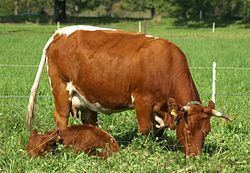Country of origin Austria Scientific name Bos taurus | Rank Breed | |
 | ||
Other names Tux-ZillertalerTuxTuxerZillertalZillertalerTiroleseTyrolean Use formerly cow-fighting; now meat, vegetation management Weight Male: 1100 kgFemale: 600 kg Height Male: 130 cmFemale: 125 cm Similar Ennstaler Bergscheck, Pustertaler Sprinzen, Tyrolese Grey cattle, Pinzgauer cattle, Murboden cattle | ||
The Tux-Zillertal, German: Tux-Zillertaler, is an endangered Austrian breed of domestic cattle. It was created in 1982 when two similar Alpine breeds, the Tux and the Zillertal, were merged.:317 The two names derive from those of the municipality of Tux in the Tuxertal, and of the neighbouring Zillertal, both in the Tirol region of Austria. The Tux-Zillertal may derive from the Swiss Hérens breed. Like the Hérens, it was long selected for the fighting ability of the cows, at the expense of productive characteristics.:116
Contents
History
The Tux-Zillertaler breed was created in 1982 by merging the remaining populations of the two similar Alpine breeds, the Tux and the Zillertal. Both breeds are similar to the Hérens breed of Switzerland, and are sometimes thought to have derived from it.:116 The Tux breed was formerly common in Tyrol and in other parts of Austria. Today it is kept mainly in the Zillertal. In 1930 there were some 4500 head. By 1970 the number had fallen to 30, and systematic conservation efforts were begun.:77 A study in 2002 found a total population of 471 head:175 In 2014 a population of 1117–2500 was reported.
Characteristics
The Tux-Zillertsal is of medium size, powerfully built with a strong neck and strong black-tipped horns.:77 The coat is black or red, with white markings on the pelvis, the root of the tail, the underbelly and on the udder. The black colour derives from the Tux breed, and the red from the Zillertal.:76 The skin is dark, the nose and hooves black.:77 The Tux-Zillertal is a frugal breed, well adapted to high mountain pastures.
Use
As with the Hérens and Évolène breeds of Switzerland, cows are used for cow-fighting contests, and have long been selectively bred for this purpose rather than for productive characteristics, resulting in decreased milk performance. The milk has an exceptionally high fat content.:76
